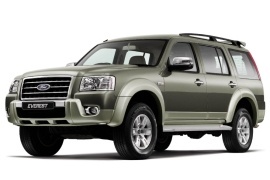
FORD Everest
Generations Timeline, Specs and Pictures

Ford introduced the second generation of the mid-size SUV Everest in the Asia-Pacific area.
Like its predecessor, it was built on the same chassis with the Ranger pickup-truck.
The first generation of the Everest was introduced in 2003 and it went through a major facelift in 2007. By 2015 it was already an outdated vehicle and the car maker decided that it was time for a major change. By using the same design language as the Ford Edge, the car company assigned the Australian branch to design and develop a successor for the Everest. The result was an SUV with the front side of a Ranger. After the B-pillar, the car was different. It featured a longer roof and different rear doors than the pickup version. An additional window was mounted behind the C-pillar.
Inside, the Everest featured the same dashboard as the Ranger, with a three-dials instrument cluster. A mix of the digital and analog panel was offered as an option. The SYNC2 infotainment system was Apple CarPlay and Android Auto compatible. The Everest could host up to seven passengers on three rows, but the standard version was fitted with only five seats.
For the powertrain, the car was fitted with a choice of three engines: a 2.0-liter Ecoboost, a 2.2-liter TDCI engine, or the top-of-the-range 3.2-liter turbodiesel with an inline-five configuration. Power went to the rear and all four corners via a transfer box and a low-gear.

Ford produced in 2003 a big SUV based on the same chassis as the Ford Ranger pickup and named it Everest.
Four years later, the carmaker introduced a refreshed version.
One of the cheapest ways to build an SUV with true off-road abilities is to take a 4x4 pickup and bolt a different body on top of the chassis. Mitsubishi used the same recipe for the Pajero Sport with the chassis from the L200, and Ford did it with the Everest built on top of a Ranger pickup. It used most body parts from the latter and added a different backside.
At the front, it featured the updated grille of the Ranger pickup with three slim chromed slats and redesigned bumper and headlights. Unlike its utility vehicle, the Everest featured a longer roof extended all the way to the back of the car. The spare wheel was replaced from under the car to the back, on a swing-out cradle.
Inside, the Everest featured a similar dashboard with the facelifted Ranger model, but after the front seats, everything was changed. There were three rows of seats in the car, allowing up to seven passengers. The middle row was 60/40 split-folding, and there was another bench in the back, over the rear axle.
Ford installed two engine choices under the hood, both diesel and paired to a 5-speed manual gearbox. A transfer box with a low-range gear was fitted as standard on all models.

Revealed to he public for the first time in 2003 at the 24th Bangkok International Motor Show, the Everest was a mid-size SUV designed for the Asian markets.
Based on the Ford Ranger, the exterior look was similar and they also shared at least 60% of the mechanical components, such as the 2.5-liter turbodiesel engine, the double wishbone independent front suspension and the leaf spring rear suspension.
The aim was to create a better Ranger, with improved comfort and handling.
The 2.5-liter engine developed 110 hp, mated with a 5-speed manual transmission or a 4-speed automatic. The Everest was available with a two-wheel-drive or a four-wheel-drive system.
The Everest offered seating for 7 in a roomy cabin, while the cargo area was generous.
While the engine was not a powerful one, it offered decent performance for the Everest to perform well on different road types. The Everest handled well with rougher terrains, however, it was not a disappointment at highway speeds and on longer journeys either.
Different systems for enhanced safety and comfort were available, such as power steering, anti-lock braking system, driver and passenger airbag, power front windows, air conditioning and fog lights.
Overall, the Everest offered reliable performance for a price that other SUVs could not have offered.























































